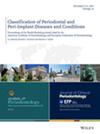Dental-implant inflamed surface area: A quantification and simulation study
Abstract
Background
Peri-implantitis is an oral inflammatory disease with increased incidence across the population as linked to the wide use of dental implants to replace missing teeth. While the recent World Workshop Classifications provided a framework for clinicians to diagnose and assess the severity of peri-implantitis, an objective assessment of the mucosal inflammatory burden around the dental implant is still lacking. Based on the periodontal epithelium surface area (PESA) and periodontal inflamed surface area (PISA) scores previously reported, a study was conducted to explore a similar approach for peri-implant inflammatory surface quantification. The aim of this study was to develop two novel scores of peri-implant mucosal inflammation and their clinical application to help with the quantification of the dental-implant inflamed surface area (DISA).
Methods
Formulas were created to quantify the dental-implant surface area (DESA), and then DESA of both tapered and cylinder implants was compared based on a dataset that included probing pocket depth, mucosal recession, and implant morphology parameters. The DISA was subsequently calculated using the epithelial/connective tissue areas multiplied by the proportion of bleeding on probing sites around the implant. The new scores were applied and validated using clinical cases of peri-implantitis.
Results
Firstly, a total of 10,000 dental implants were included in a simulation study to evaluate the performance of the new scores. Under-estimation of the real surface areas around dental implants was less than 2% when using the DESA score for cylinder and tapered dental implants (universal formula is presented). The DISA score was created in the simulations and then applied to 21 participants suffering from peri-implantitis. DESA scores ranged from 54.24 to 400.29 mm2, and the DISA scores ranged from 36.76 to 400.29 mm2.
Conclusions
Two novel scores (DESA and DISA) to estimate the peri-implant surface area in health and disease were proposed and applied to clinical cases. The inflammatory surface caused by peri-implantitis could be quantified by DISA with good precision. Future steps could include microbiome assessments and investigation of the association of these scores with the host response and general health status of patients with peri-implantitis.
Plain Language Summary
Peri-implantitis is a common gum disease surrounding dental implants. Although recent guidelines help diagnose it, there's still no clear way to measure the inflammation surface area around implants. We developed formulas to calculate the dental-implant surface area (DESA) and compared them for different implant shapes using data on pocket depth, gum recession, and implant type. We then calculated the dental-implant inflamed surface area (DISA) by multiplying the tissue area around the implant by the proportion of bleeding sites. In our study, we included data from 10,000 implants to test the new scores. The DESA score was very accurate, underestimating the real surface area by < 2%. We then used the DISA score on 21 patients with peri-implantitis. The DESA scores ranged from 54.24 to 400.29 mm2, while the DISA scores ranged from 36.76 to 400.29 mm2. In conclusion, we introduced two new scores (DESA and DISA) to measure the inflammation caused by peri-implantitis. These scores could help in better diagnosing and treating peri-implantitis, with future research exploring their link to overall health.





 求助内容:
求助内容: 应助结果提醒方式:
应助结果提醒方式:


